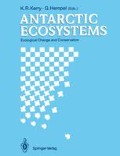Summary
At Amsterdam Island, cattle were introduced in 1871 but there were no native coprophagous fauna. This chapter focuses on the succession of the fauna involved in dung degradation during a summer, 90-day experiment and on changes in water, dry matter and nitrogen contents. A small number of invertebrate species was sampled from the dung and the soil beneath it. The presence of Diptera larvae (mainly Fucellia tergina), caterpillars (Noctuidae) and earthworms (Dendrobaena rubida tenuis and D. subrubicundd) was noticed. Porcellio scaber (Isopoda) was dominant and the dry matter and nitrogen losses may be related especially to the activity of this species which leads to a coarse fragmentation of dung and its conversion to fecal pellets.
Access this chapter
Tax calculation will be finalised at checkout
Purchases are for personal use only
Preview
Unable to display preview. Download preview PDF.
References
Aubert de la Rüe E (1932) La flore et la faune des Iles Saint-Paul et Amsterdam. Terre Vie 2:642–662
Bornemissza GF (1960) Could dung eating insects improve our pastures? J Aust Inst Agric Sci 26:54–56
Bornemissza GF (1976) The Australian dung beetle project 1965–1975. Aust Weed Res Comm Rev 30:1–30
Daycard L (1985) Situation écologique de l’Ile Amsterdam: Bilan et Avenir. Mémoire de D.E.A., Université de Montpellier
Daycard L, Decante F (1989) Etude d’une population de bovins sauvages sur l’Ile Amsterdam. Essai de contrôle et de gestion. In: Laubier L (ed) Actes du colloque sur la recherche française dans les terres australes, 14–17 Sep 1987, Territoire des Terres Australes et Antarctiques Françaises, Strasbourg, pp 279–285
Decante F, Jouventin P, Roux JP, Weimerskirch H (1987) Projet d’aménagement de l’Ile Amsterdam. Rapport Ministère de l’Environnement, Terres Australes et Antarctiques Françaises, Centre d’Etudes Biologiques des Animaux Sauvages. 91 p
Dreux P (1970) Contribution à l’étude des arthropodes terrestres et d’eau douce dans les Terres Australes Françaises. Terres Aust Antarct Fr 50:1–4
Enderlein G (1903) Die Landarthropoden der von der Tiefsee Expedition besuchten Antarktischen Inseln. 2. Die Landarthropoden der Antarktischen Inseln St-Paul and Neu-Amsterdam. Wiss Erg Dtsch Tiefsee Exped Valdivia 1898–1899, Jena, pp 249–269
Enderlein G (1909) Die Insekten des Antarktischen Gebietes. Deutsche Südpolar Expedition 1901–1903, Zool, Band X, Berlin, pp 361–528
Gillard P (1967) Coprophagous beetles in pasture ecosystems. J Aust Inst Agric Sci 33:30–34
Giret A (1987) Géologie des Terres Australes Françaises. Com Natl Fr Rech Antarct 58:17–41
Holter P (1975) Energy budgets of a natural population of Aphodius larvae (Scarabaeidae). Oikos 26:177–186
Holter P (1979) Effect of dung beetles (Aphodius spp.) and earthworms on the disappearance of cattle dung. Oikos 32:393–402
Hugues RD (1975) Introduced dung beetles and Australian pasture ecosystems. J Appl Ecol 12:819–837
Jolinon JC (1987) Les Phanérogames adventices sur l’Ile Amsterdam. Com Natl Fr Rech Antarct 58:183–188
Landin BO (1961) Ecological studies on dung beetles (Coleoptera Scarabaeidae). Opuse Entomol (Suppl) 19:1–227
Lussenhop J, Kumar R, Wicklow DT, Lloyd JE (1980) Insect effects on bacteria and fungi in cattle dung. Oikos 34:54–58
Macqueen A, Beirne B.P. (1975) Influence of some dipterous larvae on nitrogen loss from cattle dung. Env Entomol 4:868–870
Olechowicz E (1976) The role of coprophagous dipterans in a mountain pasture ecosystem. Ekol Pol 24:125–165
Paulian R, Pic M (1953) Un Anobiide des Phylica de l’Ile Nouvelle Amsterdam. Rev Fr Ent 20:43–45
Putman RJ (1983) Carrion and dung: the decomposition of animal wastes. Edward Arnold, London
Schiner JR (1868) Diptera. Reise öster. Freg. Novara 1857–1859, Zool, Wien, pp 388
Séguy E (1959) Insectes Diptères de l’Ile Amsterdam (Mission de M. Patrice Paulian, 1955–1956). Mem Mus Nat Hist Nat Ser A 17:133–154
Stevenson BG, Dindal DL (1987) Functional ecology of coprophagous insects: a review. Pedobiologia 30:285–298
Stonehouse B (1982) La zonation écologique sous les hautes latitudes australes. Com Natl Fr Rech Antarct 51:532–537
Strand E (1909) Spinnentiere von Südpolar-Expedition 1901–1903. Deutsche Südpolar Expedition, Zool, Band X, Berlin, pp 541–596
Travé J (1973) Recherches sur les microarthropodes terrestres des Iles Amsterdam et Saint-Paul. I. Ile Amsterdam: Etude quantitative préliminaire. Rev Ecol Biol Sol 10:295–306
Travé J (1974) Recherches sur les microarthropodes terrestres des Iles Amsterdam et Saint-Paul. II. Ile Saint-Paul: Etude quantitative préliminaire et comparaisons entre les deux îles. Rev Ecol Biol Sol 11:519–532
Vanhöffen E (1909) Tiere und Pflanzen von Saint-Paul und Neu-Amsterdam. Deutsche Südpolar Expedition, Band II, Berlin, pp 399–410
Vélain C (1877) Remarques générales au sujet des Iles Sain-Paul et Amsterdam. Arch Zool Exp 6:1–144
Vélain C (1893) Les Iles Saint-Paul et Amsterdam. Ann Géogr 2:329–364
Viette P (1959) Lépidoptères de l’Ile Amsterdam (récoltes de Patrice Paulian, 1955–1956). Bull Soc Entomol Fr 64:22–29
Zur Strassen R (1981) On the Thysanoptera (Insecta) from some islands in the sub-antarctic part of the Indian Ocean. Com Natl Fr Rech Antarct 48:159–169
Author information
Authors and Affiliations
Editor information
Editors and Affiliations
Rights and permissions
Copyright information
© 1990 Springer-Verlag Berlin Heidelberg
About this paper
Cite this paper
Tréhen, P., Frenot, Y., Lebouvier, M., Vernon, P. (1990). Invertebrate Fauna and Their Role in the Degradation of Cattle Dung at Amsterdam Island. In: Kerry, K.R., Hempel, G. (eds) Antarctic Ecosystems. Springer, Berlin, Heidelberg. https://doi.org/10.1007/978-3-642-84074-6_37
Download citation
DOI: https://doi.org/10.1007/978-3-642-84074-6_37
Publisher Name: Springer, Berlin, Heidelberg
Print ISBN: 978-3-642-84076-0
Online ISBN: 978-3-642-84074-6
eBook Packages: Springer Book Archive

